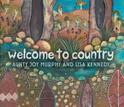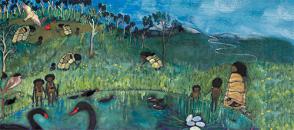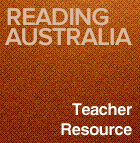AustLit
Latest Issues
AbstractHistoryArchive Description
'This is an expansive and generous Welcome to Country from a most respected Elder, Aunty Joy Murphy, beautifully given form by Indigenous artist Lisa Kennedy.
'Welcome to the traditional lands of the Wurundjeri People. We are part of this land and the land is part of us. This is where we come from. Wominjeka Wurundjeri balluk yearmenn koondee bik. Welcome to Country.'
Source: Publisher's blurb.
Reading Australia
This work has Reading Australia teaching resources.
Unit Suitable ForAC: Year 3 (NSW Stage 2)
DurationThis is an extensive unit that might take up to 6 weeks
Curriculum Summary
Find a summary table for Australian Curriculum: English content descriptions and NSW Syllabus outcomes for this unit.
Themes
Aboriginal history and culture, Books by Indigenous creators, connection to place, connection to the natural world, connections to Country, Respect, the environment
General Capabilities
Ethical understanding, Intercultural understanding
Cross-curriculum Priorities
Aboriginal and Torres Strait Islander histories and cultures, Sustainability
Publication Details of Only Known VersionEarliest 2 Known Versions of
Works about this Work
-
'We Feel the Roots of This Land Beneath the Soles of Our Bare Feet” : A Diffractive Reading of Plant Representation in Welcome to Country and The Rabbits
2023
single work
criticism
— Appears in: Storying Plants in Australian Children's and Young Adult Literature : Roots and Winged Seeds 2023; (p. 51-73)'The picturebooks Welcome to Country: A Traditional Aboriginal Ceremony by Aunty Joy Murphy and Lisa Kennedy (2016) and The Rabbits (2008/2020) by John Marsden and Shaun Tan both thematise human relationships to land, from differing cultural viewpoints. Here, I investigate the role played by plants in the representation of the human-to-land interrelationship in the two works. Inspired by a diffractive reading methodology, I explore how both picturebooks, although they sprout from differing cultural epistemologies, draw on the power of trees to symbolise and explain cultural and ecological relationships. Since the two primary texts establish their own life world governed by differing epistemologies—and since uncovering this as a significant part of the analysis—I do not approach the texts with the same analytical lens. Rather, focussing on plant representation, I draw on the stories of Aboriginal Elders in my reading of Welcome to Country and on perspectives from colonial botany to discuss The Rabbits.' (Publication abstract)
-
Aboriginal Australian Picturebooks : Ceremonial Listening to Plants
2023
single work
criticism
— Appears in: Storying Plants in Australian Children's and Young Adult Literature : Roots and Winged Seeds 2023; (p. 35-50)'Walking through the Australian bush is a walk through a living library. From the moment the Ancestors moved through Country, creating all the sentient beings, we can still see today, and those that we can’t, Australian plants and trees have held both physical and psychic, tangible and sacred knowledges. This chapter explores the possible portals of access that are opened to hearing the stories and languages of Australian plants and trees when shared by Aboriginal Australian peoples through the form of the picturebook. Such contemporary Australian books weave with ancient ways of knowing to create nurturing spaces for all readers to see, touch, smell, hold and taste the world around them. Through their own forms of Story and Language, plants and trees give insight into medicines, tools and food, as well as kinship, seasons and ceremony. When woven with picturebook modalities, they encourage embodied relationships with non-human and more-than-human elements of Country.' (Publication abstract)
-
Embedding Indigenous Perspectives in Reviewing Welcome to Country with Australian High-School Students:
2016
single work
review
— Appears in: Jeunesse : Young People, Texts, Culture , Winter vol. 8 no. 2 2016; (p. 142-151)
— Review of Welcome to Country 2016 single work picture book'The writing of this book review and the unusual form it ultimately took came about because of a variety of fortuitous coincidences. To begin with, I was asked if I was interested in writing a review of Indigenous children’s literature for this journal. I was interested, but as a non-Indigenous woman, I felt it would be a better, more accurate review if written by an Indigenous reviewer, so I gave the editors some potential names. The same week, the Ashgrove Children’s Literature Festival in Brisbane, Australia, contacted me and asked if I would like to run a workshop at a private secondary school during Literature Week. I have been involved for some time in the work of embedding Indigenous perspectives in curricula, so an opportunity to apply them to an “authentic” school-based workshop as part of a literary festival seemed too good an opportunity to forgo. The third coincidence: I was getting to know Chenoa Masters, an impressive young Indigenous pre-service teacher. And so this project came together. Chenoa and I decided that we would lead the workshop and review a new Indigenous-authored picture book, Aunty Joy Murphy and Lisa Kennedy’s Welcome to Country, together with the high-school students who took part in the workshop. In the process, we would all engage in what we expected would be an authentic book-reviewing workshop (authentic because it was to be published), with a genuine reason to embed Indigenous perspectives.' (Introduction)
-
Welcome to Country : Aunty Joy Murphy
2016
single work
review
— Appears in: Good Reading , October 2016; (p. 60)
— Review of Welcome to Country 2016 single work picture book -
Review : Welcome to Country
2016
single work
review
— Appears in: The Advertiser , 1 October 2016; (p. 36)
— Review of Welcome to Country 2016 single work picture book
-
Review : Welcome to Country
2016
single work
review
— Appears in: The Advertiser , 1 October 2016; (p. 36)
— Review of Welcome to Country 2016 single work picture book -
Welcome to Country : Aunty Joy Murphy
2016
single work
review
— Appears in: Good Reading , October 2016; (p. 60)
— Review of Welcome to Country 2016 single work picture book -
Embedding Indigenous Perspectives in Reviewing Welcome to Country with Australian High-School Students:
2016
single work
review
— Appears in: Jeunesse : Young People, Texts, Culture , Winter vol. 8 no. 2 2016; (p. 142-151)
— Review of Welcome to Country 2016 single work picture book'The writing of this book review and the unusual form it ultimately took came about because of a variety of fortuitous coincidences. To begin with, I was asked if I was interested in writing a review of Indigenous children’s literature for this journal. I was interested, but as a non-Indigenous woman, I felt it would be a better, more accurate review if written by an Indigenous reviewer, so I gave the editors some potential names. The same week, the Ashgrove Children’s Literature Festival in Brisbane, Australia, contacted me and asked if I would like to run a workshop at a private secondary school during Literature Week. I have been involved for some time in the work of embedding Indigenous perspectives in curricula, so an opportunity to apply them to an “authentic” school-based workshop as part of a literary festival seemed too good an opportunity to forgo. The third coincidence: I was getting to know Chenoa Masters, an impressive young Indigenous pre-service teacher. And so this project came together. Chenoa and I decided that we would lead the workshop and review a new Indigenous-authored picture book, Aunty Joy Murphy and Lisa Kennedy’s Welcome to Country, together with the high-school students who took part in the workshop. In the process, we would all engage in what we expected would be an authentic book-reviewing workshop (authentic because it was to be published), with a genuine reason to embed Indigenous perspectives.' (Introduction)
-
Aboriginal Australian Picturebooks : Ceremonial Listening to Plants
2023
single work
criticism
— Appears in: Storying Plants in Australian Children's and Young Adult Literature : Roots and Winged Seeds 2023; (p. 35-50)'Walking through the Australian bush is a walk through a living library. From the moment the Ancestors moved through Country, creating all the sentient beings, we can still see today, and those that we can’t, Australian plants and trees have held both physical and psychic, tangible and sacred knowledges. This chapter explores the possible portals of access that are opened to hearing the stories and languages of Australian plants and trees when shared by Aboriginal Australian peoples through the form of the picturebook. Such contemporary Australian books weave with ancient ways of knowing to create nurturing spaces for all readers to see, touch, smell, hold and taste the world around them. Through their own forms of Story and Language, plants and trees give insight into medicines, tools and food, as well as kinship, seasons and ceremony. When woven with picturebook modalities, they encourage embodied relationships with non-human and more-than-human elements of Country.' (Publication abstract)
-
'We Feel the Roots of This Land Beneath the Soles of Our Bare Feet” : A Diffractive Reading of Plant Representation in Welcome to Country and The Rabbits
2023
single work
criticism
— Appears in: Storying Plants in Australian Children's and Young Adult Literature : Roots and Winged Seeds 2023; (p. 51-73)'The picturebooks Welcome to Country: A Traditional Aboriginal Ceremony by Aunty Joy Murphy and Lisa Kennedy (2016) and The Rabbits (2008/2020) by John Marsden and Shaun Tan both thematise human relationships to land, from differing cultural viewpoints. Here, I investigate the role played by plants in the representation of the human-to-land interrelationship in the two works. Inspired by a diffractive reading methodology, I explore how both picturebooks, although they sprout from differing cultural epistemologies, draw on the power of trees to symbolise and explain cultural and ecological relationships. Since the two primary texts establish their own life world governed by differing epistemologies—and since uncovering this as a significant part of the analysis—I do not approach the texts with the same analytical lens. Rather, focussing on plant representation, I draw on the stories of Aboriginal Elders in my reading of Welcome to Country and on perspectives from colonial botany to discuss The Rabbits.' (Publication abstract)
Awards
- 2017 shortlisted Speech Pathology Australia Book of the Year Awards — Indigenous Children
- 2017 recommended Australian Family Therapists' Award for Children's Literature — Picture Book and Younger Readers
- 2017 shortlisted Educational Publishing Awards Australia — Primary — Educational Picture or Chapter Book
- 2017 winner The Wilderness Society Environment Award for Children's Literature — Non-Fiction
- 2017 shortlisted New South Wales Premier's Literary Awards — Patricia Wrightson Prize for Children's Books










